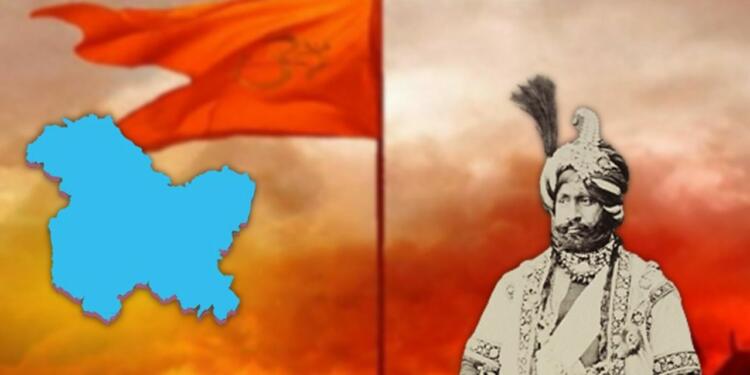Dogra dynasty Kashmir: Presently, the province of Kashmir is predominantly Muslim, indicating that Muslims make up the majority of the population. However, this was not always the case, and there was a time when a Kashmiri ruler attempted to revive the region’s original religious practices. Regrettably, this effort was unsuccessful. In this article, we will explore an instance where Kashmir had the opportunity to revert to its saffron roots, but due to the disappointment of certain individuals, this did not come to fruition.
Kashmir: From Karkot Dynasty to Dogra Raj
The statements “Kashmir is ours where Shiva, Saraswati, and Rishi Kashyap resided” and “Kashmir is ours where Shankaracharya meditated” were not casually mentioned in “The Kashmir Files.” These declarations reflect the true essence of Kashmir. At one point in time, Kashmir was not only a geographical crown of India but also a spiritual and cultural one.
The Karkot dynasty, which emerged from Kashmir, safeguarded India from external aggressors for almost three centuries. If the leftist ideology did not dominate, the Mughals would not have received as much recognition, and instead, Emperor Lalitaditya Muktpid would have been celebrated for his valor. His heroic feats would have been instilled in every child’s mind across the country.
In the past, Kashmir was ruled by formidable leaders such as Didda, who prevented Mahmood Ghaznavi from even venturing near the region. However, by the 14th century, the circumstances altered, and like other parts of India, Kashmir fell under the influence of Islamic invaders. Despite several attempts to break free, Kashmir’s liberation only materialized in the 18th century under the joint leadership of Sikh and Hindu Dongra leaders.
Read More – Nadimarg massacre: Kashmiri Pandit genocide case is open after 19 years
Gulab Singh’s unfulfilled wish
Over time, the Dogra dynasty gained considerable power to the extent that even the Sikh Empire could not overlook them. During Maharaja Ranjit Singh’s reign, he entrusted the governance of the entire Kashmir province to a loyal warrior named Gulab Singh due to his meritorious service. Gulab Singh proceeded to delineate the present-day boundaries of Jammu and Kashmir province.
Gulab Singh was not merely a territorial delineator; he was a conscientious and devout leader who took significant strides towards reviving the Sanatan culture. Furthermore, he recognized that besides Ranjit Singh and Hari Singh Nalwa, there were no other capable leaders to govern Punjab.
Also read: 7 times the Kashmiri Pandits had to face genocide in Kashmir
When Gulab Singh was accused of “betraying” the Sikh Empire, he struck an unprecedented treaty with the British that granted them possession of Jammu and Kashmir. The treaty also exposed the British’s double standards, resulting in severe repercussions for them. Eventually, in 1846, Gulab Singh was declared the uncontested ruler of Jammu and Kashmir as the Sikh Empire had already disintegrated and was embroiled in a separate conflict with the British.
Were you aware that there was a proposal to re-Hinduize Jammu and Kashmir in 1850? It is said that many residents who had converted to Islam for various reasons wanted to revert to the Sanatan Dharma under the auspices of the Dogra dynasty of Kashmir. Maharaja Gulab Singh was also in favor of this proposal, but it did not come to fruition. The reason for its failure is unclear, but it is known that a group from Kashmir made it known that if these individuals were reconverted to the Sanatan Dharma, they would either leave Kashmir or convert back to Islam.
British historians refer to this group as “Pandits of Kashi,” but according to local sources and memoirs, they were Kashmiri Pandits who had made significant contributions to the politics and culture of Kashmir for centuries.
Read more – The exodus of Kashmiri Pandits is “fictional” for Naseeruddin Shah
If they were successful
The saying “there’s no smoke without fire” implies that there must be some truth to a rumor. This is likely the case when it comes to the strained relationship between the Dogra community and the Kashmir Pandit community, who prefer to stay apart from one another even today. It’s interesting to note that when Maharaja Hari Singh expressed his desire to accede to India, his Prime Minister Ramchandra Kak, a Kashmiri Pandit, opposed the proposal. This cannot be mere coincidence. If Maharaja Gulab Singh had acted upon his desire to re-Hinduize Jammu and Kashmir, more than half of the problems in Kashmir may have been resolved at that time.
Support TFI:
Support us to strengthen the ‘Right’ ideology of cultural nationalism by purchasing the best quality garments from TFI-STORE.COM































